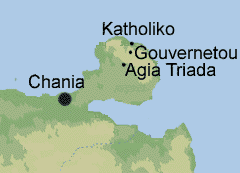
|
Folklore - Saints |
||
|
John the Hermit
|
||
|
The location of the cave |
 |
The cave of St John is situated near the north coast of Akrotiri between the Malecha headland and the Tripiti headland. On your way to the cave you first pass by the monastery of Agia Triada, and then you go on to Gouvernetou Monastery about 4 km further on. From here it is no longer possible to go on by car, so you have to continue on foot to the north along a small path towards the cave and the ruins of Katholiko Monastery. |
| On
your way you pass by the Bear Cave, in which there is a big stalagmite,
which - if you stretch your imagination - resembles a bear bending over
the cistern situated in the cave. According to tradition a living bear was
originally drinking from the water. The monks from Gouvernetou Monastery
and the local inhabitants had never seen it, but because they wondered,
why the cistern was always empty, some of the monks decided to keep watch
inside the cave to find the reason. They were terrified, when suddenly the
big bear darkened the entrance, and one of them quickly invoked the Virgin
Mary. He had hardly finished his prayer, when the bear became petrified.
And there it still stands to this very day.
|
|
| Inside
the cave a little church is built into the rock on the left. It is
dedicated to Panagia Arkoudiotissa (the bear-fighting Virgin Mary), who is
celebrated on February 2nd
by "pilgrims" from all over
Crete with a procession and a subsequently Mass. In fact the church was
already in Antiquity a home for the worship of Artemis in the shape of a
bear.
|
|
| Outside
the cave are the remains of an ancient monastery, but unfortunately there
is not much information about it.
|
|
| About
15 minutes further down the path you reach the wild Avlaki Gorge, which
leads all the way out to the sea, where you find a peculiar rock formation
looking like a ship. According
to local tradition
it is a pirate ship, which
brought pirates to the island in order to plunder Katholiko Monastery.
When the monks caught sight of the pirates, they prayed to God for help.
As it happened in the Bear Cave, also the ship immediately changed into a
big rock. The oral tradition tells us in this way about the many attacks
Crete were often exposed to - first by the Arab Saracens from Spain and
later by pirates from Algeria and Asia Minor.
|
|
| The
Englishman Robert Pashley who travelled about Crete in 1834 and wrote down
his observations, described the area around Katholiko as follows:
|
|
| This wild and sequestered spot is very near the head of the valley, and is not above a thousand paces from the sea. Many Greek monasteries are picturesque and beautiful objects; but I can recal to my recollection no place so well suited for those, who may have desired "remote from man with God to pass their days," as this glen, with its | |
| Steep and lofty cliffs, | |
| That on a wild secluded scene impress | |
| Thoughts
of more deep seclusion.
|
|
| The
descent to Katholiko Monastery begins at the edge of the gorge by steps
laboriously cut into the rock by monks, and at the end of the steps the
entrance to the cave of St John is in the immediate vicinity of the
entrance to the monastery.
|
|
| In
1962 the president of the Hellenic Speleological Society, Anna
Petrocheilou, examined and described the cave. It stretches out from
northeast towards southwest at a length of 135 m and has an extent of 1500
m2. Inside the cave you find many spectacular stalactites and
stalagmites and the riverbed of a subterranean river.
|
|